What is an Altar?
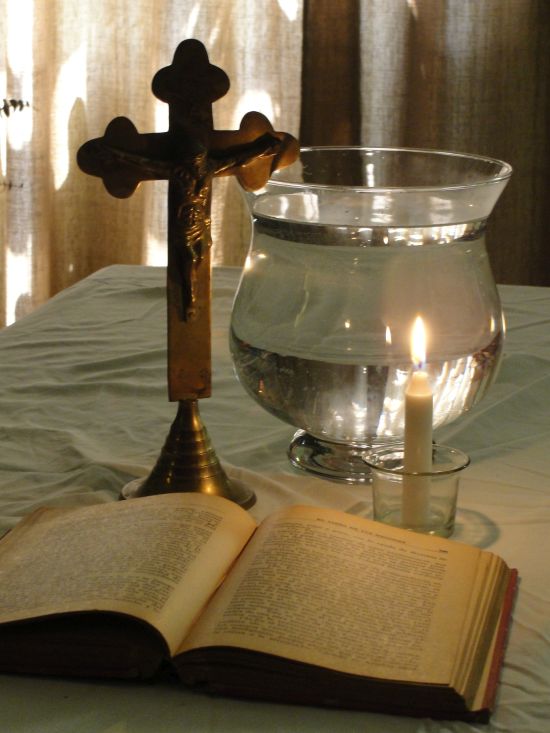 What is an Altar -meaning of the word altar
What is an Altar -meaning of the word altarWhat is an altar, and what does the word altar mean?
An altar is a sacred area where people perform spiritual rituals, give offerings, and connect with higher powers. Throughout history and across cultures, altars have played an important role in religious and spiritual practices. In this detailed guide, we'll explore different types of altars, including what an altar is, its importance, and how to create one that reflects your personal beliefs.
Comprehensive Guide
What is an Altar ?
Defining an Altar
What is an altar ?
A spiritual altar is a sacred place where individuals can connect with God, spirit messengers, and their higher selves. It serves as a focal point for reflection and spiritual growth, allowing one to offer prayers, intentions, and gratitude to the Divine.
The spiritual altar acts as a bridge between the physical and spiritual realms, enabling individuals to cultivate a deeper sense of spirituality and connection with the Divine.
In many spiritual traditions, the altar is viewed as a portal to the spiritual realm, where one can communicate with spirit guides, angels, and other divine beings, enabling individuals to cultivate a deeper sense of spirituality and connection with the Divine.
It symbolizes a threshold between the physical and spiritual worlds, helping individuals transcend their mundane concerns and connect with the sacred. It embodies the concepts of sacrifice, surrender, and devotion, inviting individuals to let go of their egos and limitations while opening themselves to the Divine.
Additionally, an altar typically serves as a sacred place for rituals and offerings, representing a connection to the divine. It is a dedicated area for spiritual activities that fosters a deeper relationship with the Divine through various practices. The word altar evokes images of a raised structure, a holy table, or a stone altar, all of which serve as central points for worship and spiritual practices.
Whether it is a small table decorated with candles and incense or a more elaborate setup featuring statues and sacred texts, the essence of a spiritual altar lies in its ability to provide a sanctuary for the soul. This personal space becomes a haven where one can retreat from the chaos of daily life and find solace in the presence of the Divine.
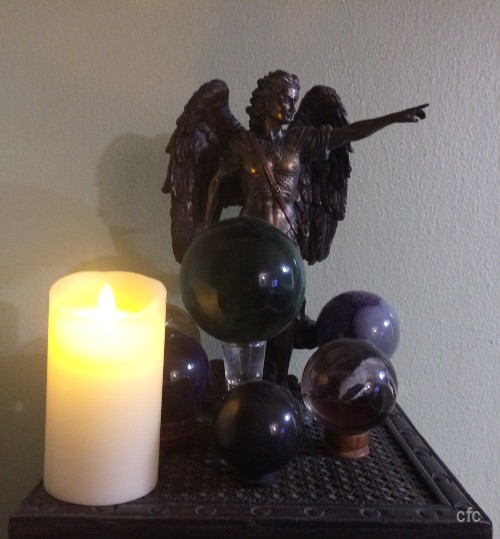
Historical Significance of Altars
Throughout history, humans have yearned to connect with God and the spiritual realm. In pursuit of this inner desire, the idea of an altar was developed.
Altar bible meaning: "In the Bible, an altar is a raised structure in a place of worship where people make offerings to God." (Google)
Ancient altars were generally erected from an unwrought stone, serving as fundamental spaces for rituals and offerings dedicated to deities. Such an altar was not just a physical structure but a sacred site where early civilizations expressed their spiritual beliefs. For example, the Jerusalem Temple served as a significant historical altar, representing the nexus of Jewish worship and identity, where sacrifices and spiritual ceremonies were central to the faith practice.
Abraham built the first altar to express his complete dedication to God, marking a significant milestone in his faith journey. He continued to build an altar to God at each place he and his family lived.
Solomon built a cedar altar in his temple dedicated to God, where he burnt offerings.
Christian altars have evolved over time from simple tables used to hold the Eucharist to elaborately decorated structures central to church services. This evolution signifies a shift in the focus of worship practices within Christianity. In ancient times, the first altars were functional and straightforward, but as religious practices became more complex, so did the altars, reflecting the growing importance of rituals and ceremonies, including those performed at the old altars.
Many cultures around the world have their unique interpretations and uses for altars. From the horned altar of ancient Israel to the intricate stone altars of the Greeks and Romans, each culture's altars tell a story of their spiritual journey. Understanding the historical significance of such altars helps us appreciate their role in modern spiritual practices.
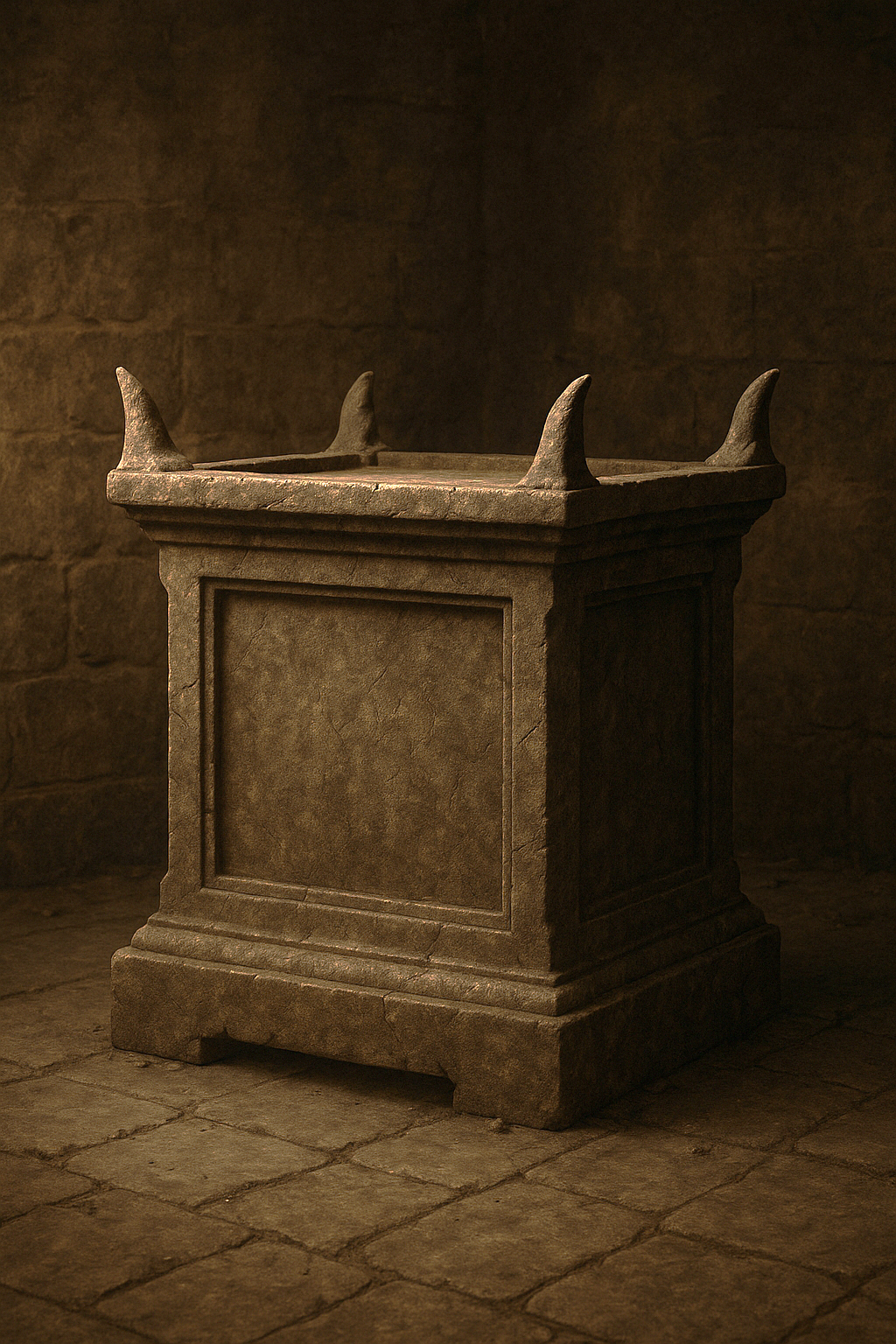 Ancient Horned Altar
Ancient Horned AltarThe Function of a Spiritual Altar
The primary function of a spiritual altar is to facilitate a deeper connection with the Divine, oneself, spirits of light, and others.
All altars share the following functions:
- Sacred Place for Worship, Prayer, Spiritual Practice, and Meditation: A place where individuals can focus their spiritual energy and engage in practices that nurture their souls and receive good energy.
- Symbolic Threshold Between the Physical and Spiritual Realms: An altar acts as a bridge, allowing individuals to transcend their everyday concerns and connect with the sacred.
- Focal Point for Spiritual Growth, Reflection, and Transformation: By regularly engaging with their altar, individuals can cultivate a deeper sense of spirituality and personal growth.
- Space for Spiritual Work, Offering Gratitude, Intentions, and Prayers: An altar serves as a dedicated space for expressing gratitude, setting intentions, and seeking guidance from the divine.
- A reminder of the Sacred and the Divine: The presence of an altar in one's home serves as a constant reminder of the spiritual aspects of life and the importance of maintaining a connection with the divine.
Power of an Altar
Altars serve as significant places for worship, sacrifice, and divine encounters, where individuals express devotion and seek spiritual connection. An altar serves as a focal point for spiritual energy, concentrating it for rituals and prayers. Whether it's a small altar in a home or a grand altar in a temple, the intention remains the same: to create a sacred area for spiritual engagement.
Such an altar can amplify spiritual energy, serving as a conduit between the physical and divine realms. It is a place where prayers are offered, rituals are conducted, and offerings are made, each act enhancing the spiritual ambiance of the space. Its power is not just in its physical form but in the spiritual intentions and practices it supports.
Types of Altars
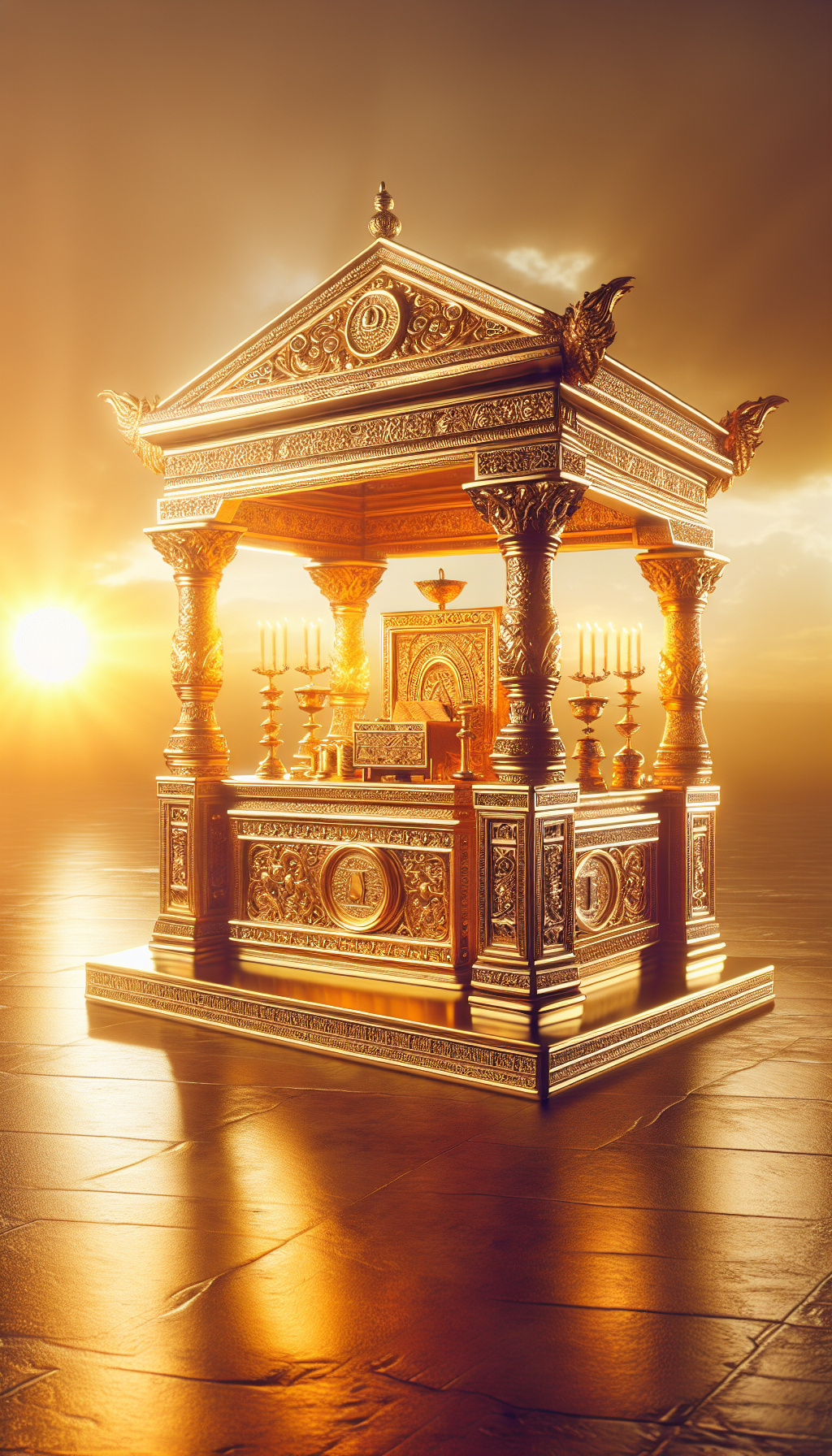 Holy Spirit - Pure Gold Altar or Altar of Incense -Tai
Holy Spirit - Pure Gold Altar or Altar of Incense -TaiIn biblical times, one type of spiritual altar was the "golden altar," also known as the "altar of incense." This altar was located within the Holy Place of the Tabernacle, where the high priest would burn incense to symbolically represent the prayers of the people ascending to God. It was made from acacia wood and entirely overlaid with pure gold, featuring horns on each corner. The altar offered a continual fragrant smoke to the Lord both day and night. (Google)
Altars come in various forms, each serving distinct purposes. A permanent altar is a fixed structure that serves as a central place for ongoing rituals and spiritual activities in a specific location. These altars can be found in temples, churches, and homes, providing a stable and sacred space for worship and offerings. On the other hand, personal altars are uniquely tailored to reflect an individual's beliefs and intentions, representing their distinct spiritual journey.
Specific types of altars include Reiki altars, Hindu altars, and Buddha altars, each designed to support particular spiritual practices. For example, a fire altar is used for rituals involving fire, symbolizing transformation and purification. An ancestor's altar is dedicated to honoring deceased family members, serving as a spiritual connection with them. Buddha's altars are places of worship in Buddhism where practitioners can meditate and pay their respects to the Buddha.
Types of altars and their purposes include:
- Meditation Altars: . A peaceful space for contemplation, reflection, and mindfulness exercises. This type of altar often features items that foster calm and tranquility, such as candles, incense, and stones. Essential oils are also commonly used.
- Spirit Guide altars: set up to invoke and honor spiritual guides, facilitating connection with one's spiritual path.
- Prayer Altar: A sacred space for offering prayers, intentions, and gratitude to a Higher Power. It may feature religious icons/pictures such as Jesus Christ, sacred texts, and other items that hold spiritual significance.
- Ritual Altar: A space for performing sacred rituals, ceremonies, and sacraments. This altar is often more elaborate, with specific tools and elements needed for various spiritual practices.
- Ancestor Altar: A space for honoring and connecting with ancestors and loved ones who have crossed over. This type of altar typically includes photos, mementos, and offerings that pay tribute to deceased loved ones.
- Other specialized altars include Shamanism altars, Voodoo altars, and Crystal altars, each supporting specific rituals and spiritual practices.
From organized religion altars in churches to one's own altars in homes, the variety of altars reflects the diverse ways people connect with their spirituality. Each type of altar serves a unique purpose, enhancing the spiritual experience of the practitioner.
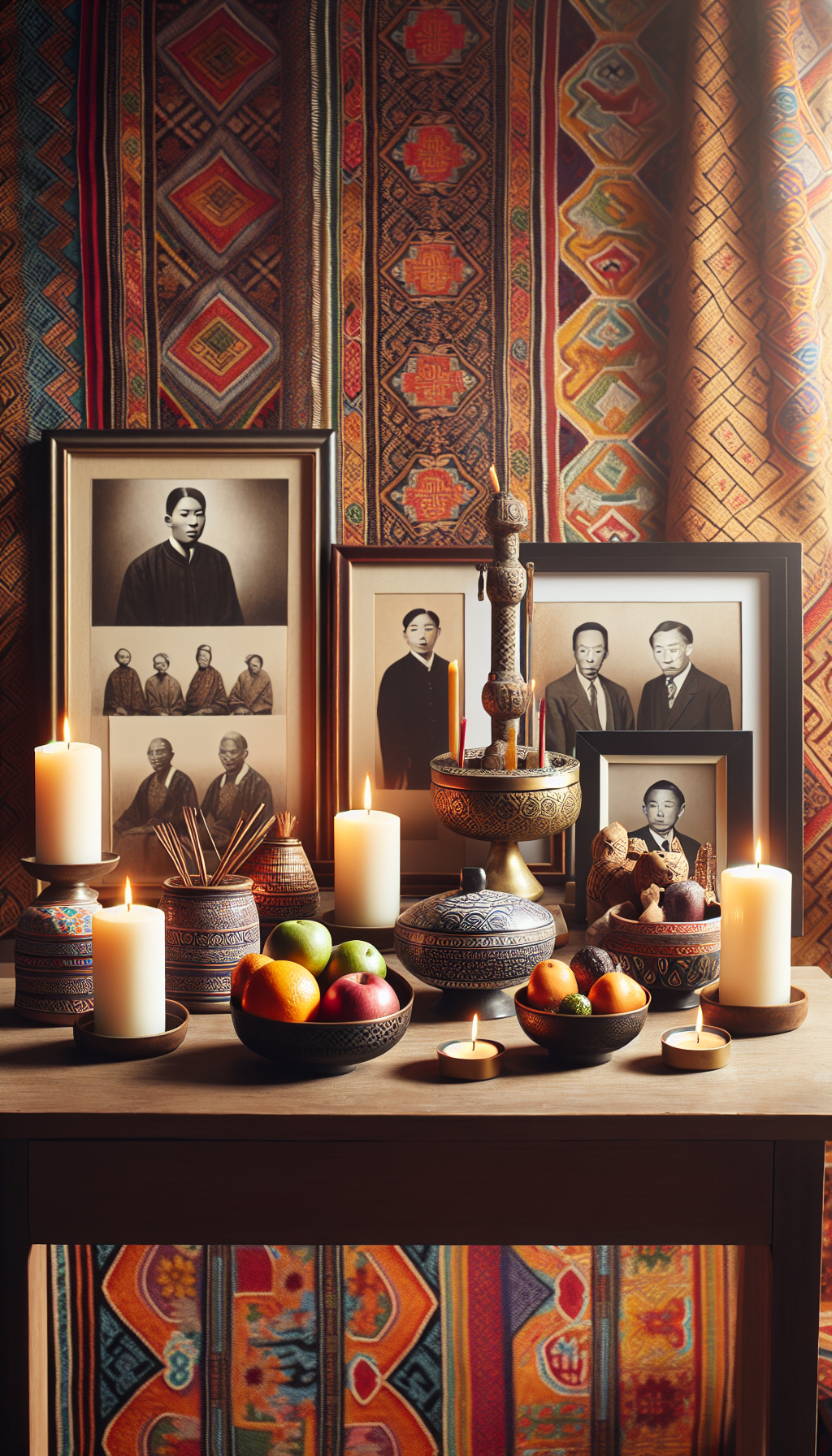 Ancestor Altar -Personal Altar by Tai
Ancestor Altar -Personal Altar by TaiCreating Your Own Altar
Creating your own altar involves defining its purpose, selecting meaningful items, and arranging them in a way that reflects your spiritual journey. This process is deeply personal, embodying your beliefs and intentions. Whether you opt for a simple altar with essential elements or a more elaborate setup, the key is to create a space that feels sacred and personal to you.
Selecting items that resonate with your spiritual experience is important, as is placing them with intention and reverence. These items may include candles, incense, sacred texts, and personal mementos. Arranging these items can serve as a meditative practice, helping you center your thoughts and focus your spiritual energy. Whether you seek guidance, wish to offer thanks, or simply want to spend time in quiet reflection, your spiritual altar can be a powerful tool for deepening your connection with the divine.
Choosing a Location
Choosing a sacred and personal location for your altar is crucial. A suitable altar space should be:
- A quiet corner of your home or a special outdoor spot
- Free from distractions to enhance your spiritual practice
- Both accessible and discreet, even in conspicuous places
- Serve as a consistent reminder for your spiritual practice
Place the altar where it combines convenience with privacy, ensuring it's accessible yet not disruptive to daily life. Finding the right spot for your altar can significantly impact its effectiveness and your connection to it.
"In certain belief systems, the northern side of an altar often holds symbolic meaning. For example, in Judaism, the northern side is associated with atonement and turning to God. In Wicca, the northern side can represent earth, stability, and grounding." - Google.
Essential Elements of an Altar
A spiritual altar can be designed and created with various elements, including:
- Sacred Objects: Statues, icons, a particular stone or relics that hold spiritual significance. These items serve as focal points for worship and reflection.
- Candles, Incense, Holy Water, and other sensory elements help create a sacred atmosphere and can enhance the spiritual experience. The use of incense on an incense altar, for example, can symbolize the prayers rising to the heavens.
- Natural Elements: Plants, stones, or water that represent the natural world and its connection to the divine. These elements can ground the altar and bring a sense of harmony.
- Symbolic Objects: Crosses, mandalas, prayer beads or other sacred symbols that hold personal or religious significance. These items can serve as reminders of one's faith and spiritual journey.
- Personal Items: Photos, mementos, or heirlooms that hold personal meaning. Including these items can make the altar more personal and reflective of one’s unique spiritual path. This can also include tarot or oracle cards.
- Sacred Texts: Scriptures, prayers, or poetry that inspire and guide one's spiritual practice. These texts can provide wisdom and insight during times of reflection and meditation.
I remember a woman who had a Saint George's sword plant near her altar. She mentioned that the plant was believed to absorb negative energy.
The design and elements of a spiritual altar should reflect the individual's personal beliefs, values, and spiritual practices, and should be created with intention, reverence, and respect. Whether it's a simple set up with a few meaningful items or a more elaborate arrangement, the key is to create a space that resonates with your soul and supports your spiritual journey.
Remember, intention setting is primary.
Using Altars in Daily Practice
Integrating an altar into your daily routine can enhance your spiritual energy and mindfulness. Setting up an altar is essential for practitioners, as it serves as a focal point to concentrate spiritual energy. By incorporating personal rituals, such as lighting candles or using incense, you can significantly elevate the spiritual ambiance of your altar.
Engaging with sensory elements, like scents and sounds, can deepen your focus during altar practices. Altars often serve as a place of spiritual anchoring, where individuals can connect with their inner self and the wider universe. Altars are often seen as powerful symbols that facilitate connections between the physical world and spiritual dimensions.
Meditation and Prayer
Using an altar as a focal point during meditation can help deepen your practice and enhance your ability to connect with the divine. An altar can:
- Serve as a central focus for meditation and prayer
- Promote a serene atmosphere for spiritual practices
- Act as a focal point where spiritual energy can be harnessed and directed toward intentions. Many practitioners regard altars as important tools for these purposes.
Altars serve as conduits for communication between humans and divine entities, facilitating deeper spiritual interaction. Using an altar can enhance the clarity and depth of meditation and prayer practices.
Rituals and Offerings
Conducting rituals at your altar can create a sacred space for honoring deities and expressing your spiritual intentions. Making offerings at an altar can honor specific deities or spirits, and the types of offerings vary based on individual spiritual practices. Throughout history, the act of offering on altars has symbolized gratitude, devotion, and the desire for atonement, reflecting a deep spiritual significance.
Performing rituals at an altar enables personal expression and the honoring of spiritual entities or intentions. Altars are perceived as focal points where spiritual intentions converge, enhancing the practitioner's ability to manifest desires and goals.
Enhancing Your Altar Experience
An altar serves as a physical representation of your spiritual beliefs and can range from simple items to complex arrangements that reflect specific energies. Regularly incorporating new elements and sensory experiences can deepen your spiritual connections at the altar. This section will provide tips on how to deepen your spiritual connection with the altar by incorporating various elements and practices.
Incorporating the Four Elements
Integrating representations of the four elements on your altar can create a balanced spiritual environment. Each element can be symbolically represented as follows:
- Earth
- Air
- Fire
- Water
This creates a balanced and harmonious energy.
Representations of the four corners of the four elements can be positioned at cardinal points:
- Earth in the north
- Air in the east
- Water in the west
- Fire in the south
Using objects that represent these elements can enhance balance and spiritual connection during rituals.
Refreshing and Rededicating Your Altar
Maintaining an altar requires regular cleansing and the addition of new items to keep its energy vibrant. Periodically refreshing your altar can involve rearranging items and cleaning surfaces to restore focus and intention. By removing old items and replacing them with fresh offerings, you can revitalize the altar's purpose and energy.
To maintain and amplify the spiritual ambiance of your altar, consider the following practices:
- Regularly cleanse your altar with sacred herbs or water.
- Perform a ritual to rededicate your altar by lighting candles.
- Express intentions for renewed energy and focus during the ritual.
These practices help maintain a strong spiritual connection and keep the altar aligned with your evolving spiritual journey.
Always exercise extreme caution when lighting candles.
Purpose of Burnt Offerings
 Basic Altar Items
Basic Altar ItemsBurnt offerings have been an integral part of spiritual practices across various cultures and traditions. In ancient times, burnt offerings were made to appease gods and goddesses, seeking their favor, protection, and blessings. The act of burning offerings symbolized the release of negative energies, emotions, and thoughts, making way for spiritual growth and renewal. In modern spiritual practices, burnt offerings are used to purify and consecrate a space, to release attachment to material possessions, and to offer gratitude to the divine. The smoke from the burnt offerings is believed to carry prayers and intentions to the spiritual realm, facilitating communication with spirit messengers and the divine.
Incorporating burnt offerings into your spiritual practice can be a powerful way to cleanse your space and mind. Whether you are burning herbs, incense, or other sacred items, the ritual can help you let go of what no longer serves you and invite positive energy into your life. As you watch the smoke rise, you can visualize your prayers and intentions being carried to the heavens, knowing that you are connecting with a higher power.
Altars Across Cultures and Religions
Altars in Christianity
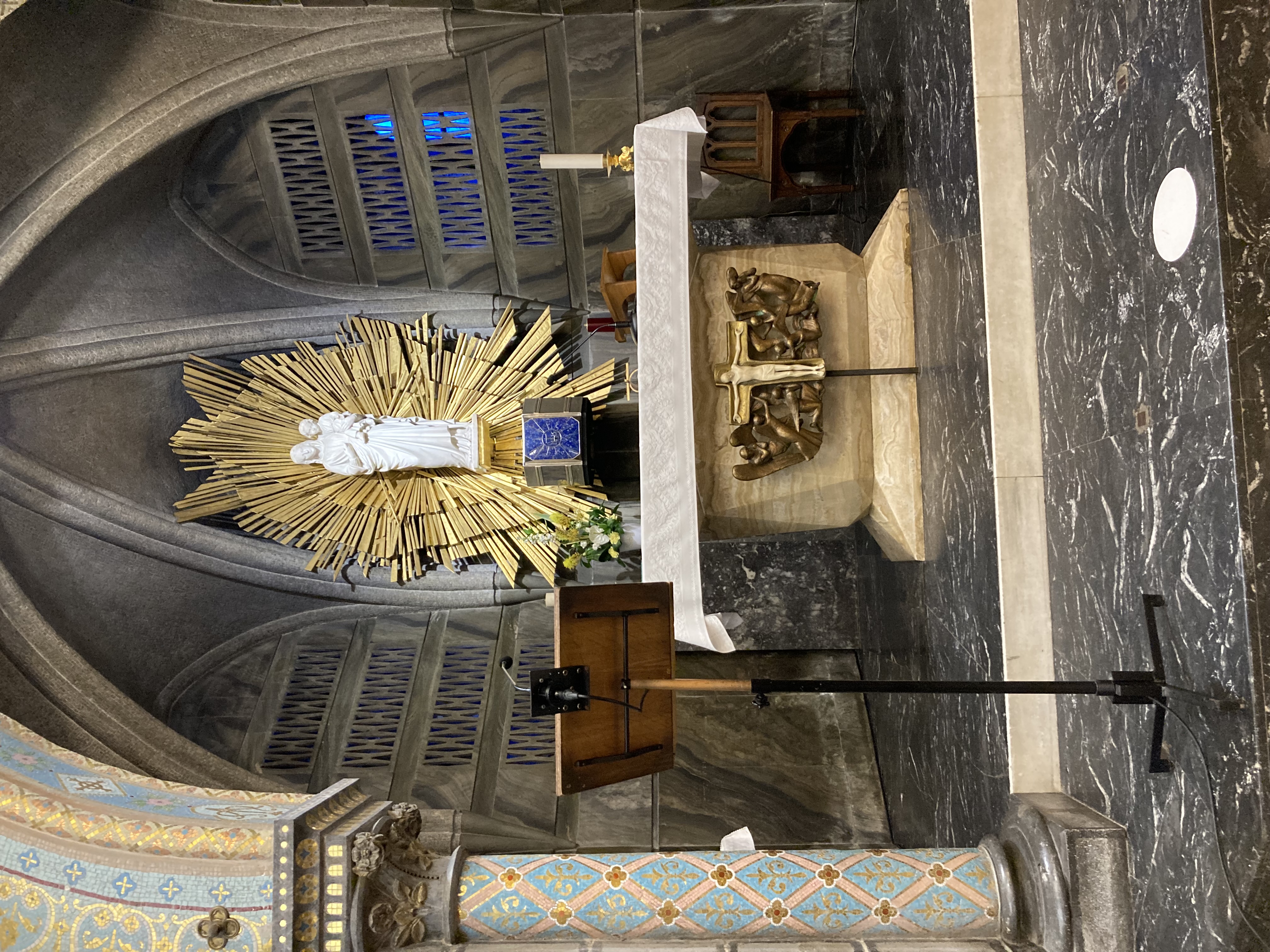 Holy Table and Holy Spirit
Holy Table and Holy SpiritIn Christian churches, the altar is a sacred space for rituals like communion, symbolizing the relationship between God and believers. The altar is often the focal point of the church, where the Divine Liturgy is performed, and believers gather to partake in the Eucharist at the Lord's Table, reflecting the presence of Jesus Christ.
Altars in Eastern Religions
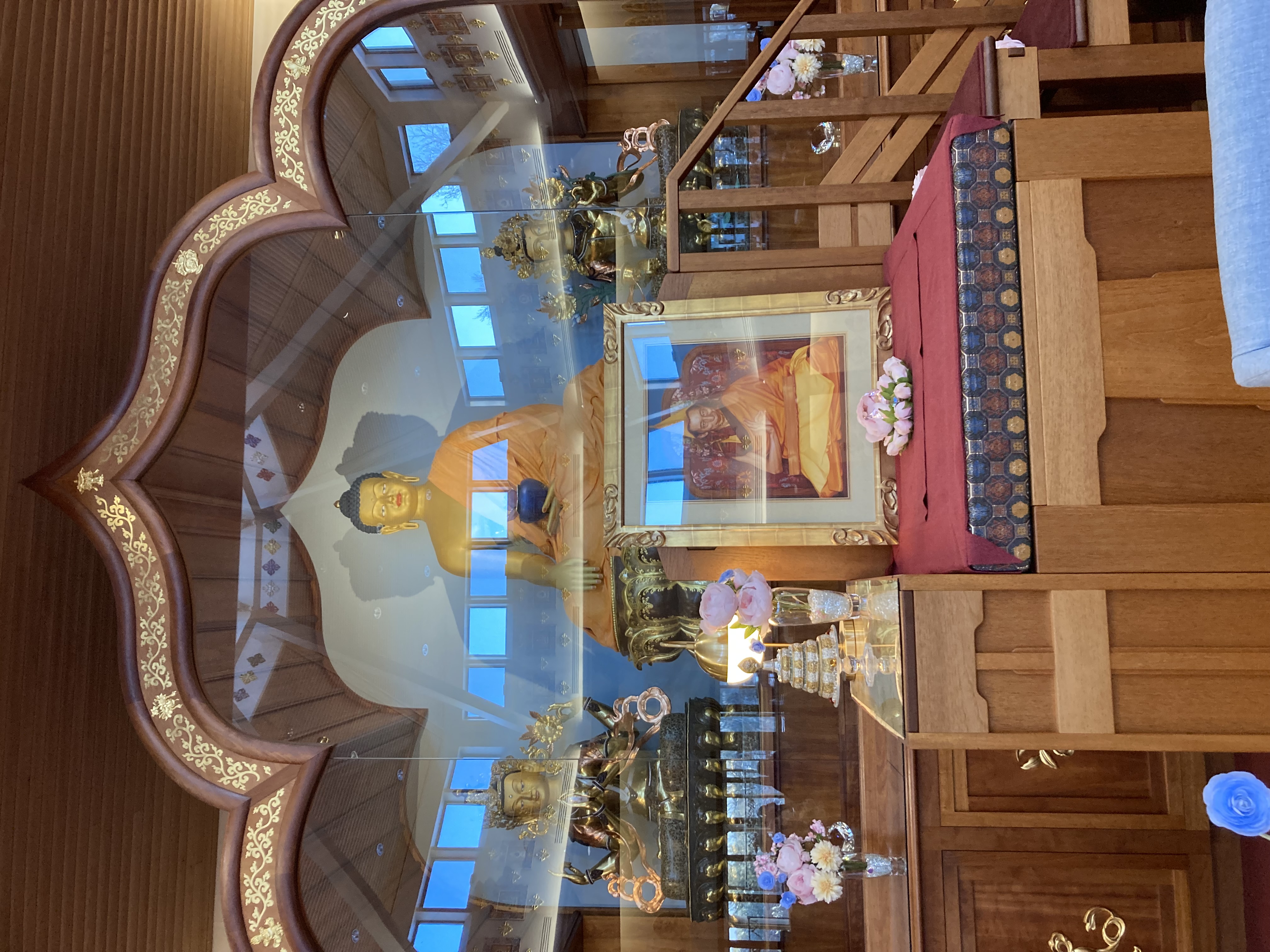
In Hinduism, altars may be found in homes and temples, showcasing images of deities alongside offerings like flowers and fruits. Hindu worship often involves altars adorned with images and idols of deities, along with offerings and ritual items. These altars serve as focal points for devotion and spiritual practices.
Buddhist altars, which often include statues of the Buddha, serve as centers for meditation, devotion, and ritual practices. Both Hindu and Buddhist altars highlight the significance of physical spaces for spiritual connection and the expression of devotion.
These many altars and shrines play a crucial role on the eastern side in Eastern religions, serving as focal points for worship and spiritual activities for the congregation, including several altars.
The Benefits of Having a Spiritual Altar
Having a spiritual altar can offer many benefits for one's spiritual journey. It provides a dedicated space for spiritual practices, allowing individuals to focus their intentions, prayers, and meditation. The altar serves as a reminder of one's spiritual commitments and goals, promoting discipline and dedication. Additionally, the process of creating and maintaining an altar can foster a sense of connection to the divine, leading to feelings of peace and inner calm. Moreover, the altar can symbolize one's spiritual identity, reflecting their values, beliefs, and aspirations. By having a spiritual altar, individuals can deepen their spiritual practice, cultivate a stronger connection with the divine, and navigate life's challenges with greater clarity and ease.
Your spiritual altar can be a peaceful sanctuary where you can escape the chaos of daily life. It serves as a space for finding solace, strength, and inspiration. By regularly engaging with your altar, you can develop a routine that supports your spiritual growth and helps you stay aligned with your higher purpose. Whether you are seeking guidance, expressing gratitude, or simply spending time in quiet reflection, your spiritual altar can be a powerful tool for nurturing your soul and deepening your connection with the divine.
My Personal Experience
When I reached a certain age, I created my own spiritual altar, which was simply a replica of what I had observed before. However, as I began to develop spiritually and connect with my spirit guides, a new perspective started to unfold. With the assistance of my spirit guides, I was able to delve deeper into the true meaning of a spiritual altar.
I learned that an altar is very personal and should reflect the essence of an individual's spiritual development, with God at the center of all.
My altar is where I turn whenever I face a situation beyond my control. It is also where I pray for others who need spiritual help. Whenever I am at my altar, I feel the presence and positive energy of my spirit guides surrounding me.
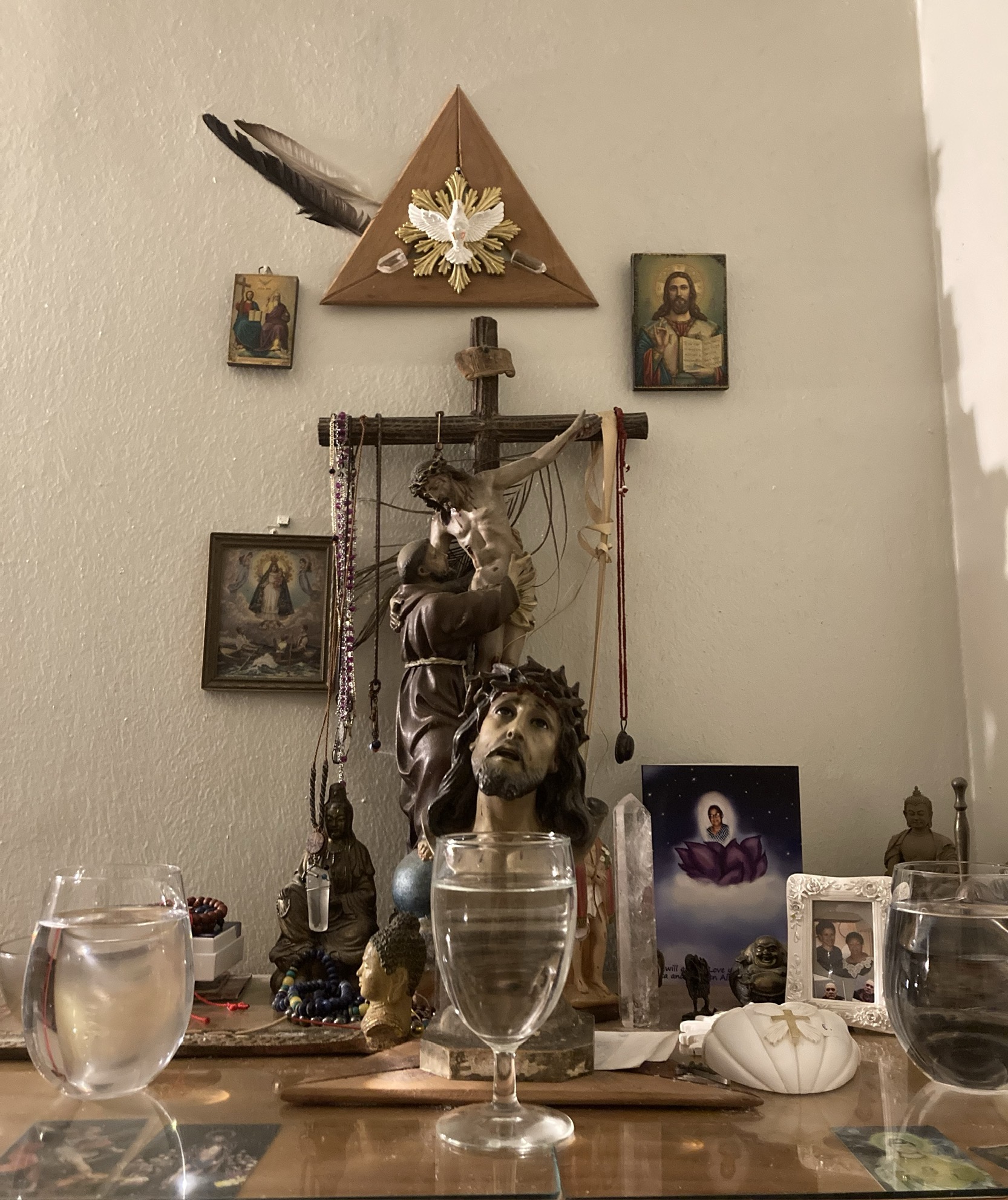 Belief System - Holy Spirit Altar
Belief System - Holy Spirit AltarWhen placing an item on an altar, it's important to understand its purpose and be aware of the energy surrounding the altar. Some items, such as crystals, can enhance energy levels. Certain spirits may suggest the use of one or two crystals on the altar, but not all altars require them; it ultimately depends on what a person's guides feel is necessary.
For example, one woman shared that she keeps both rose quartz and clear quartz on her altar to promote spiritual love and strength. These crystals serve as tools in her spiritual work.
Many people also include statues of saints on their altars, praying to these saints and expressing gratitude for the blessings they have received. It is essential to recognize that no saint or spirit can fulfill requests without God's permission. Therefore, it is advisable to place a symbol representing God in the center of the altar.
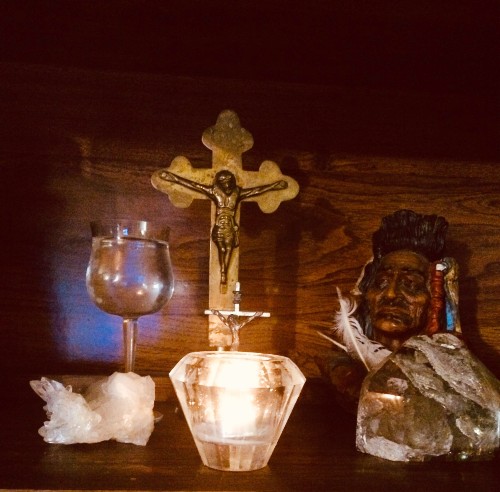 Christ and Indian Spirit Guide
Christ and Indian Spirit GuideWhen I asked one of the individuals who submitted a picture of her altar about its purpose, she shared the following:
"My altar is made up of saints who hold great significance for me. They are the saints I turned to during difficult times when I needed support. It’s a space where I can relax and gain clarity. Additionally, it is a sacred place for me to connect with my loved ones who have passed on to the spirit world."
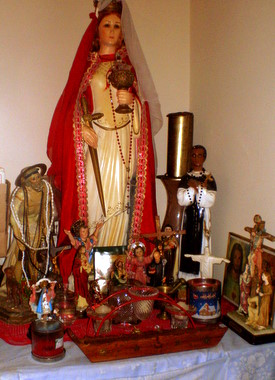
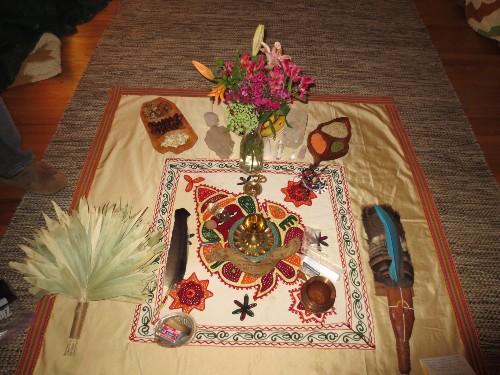 Ayahuasca Ceremonial Altar
Ayahuasca Ceremonial Altar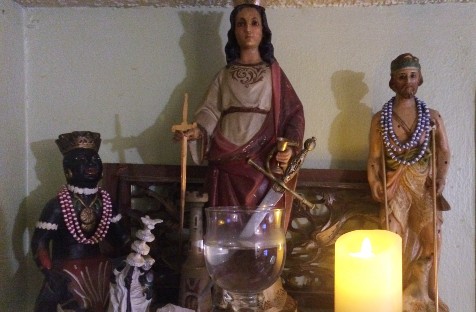 Chango, Saint Barbara and San Lazaro
Chango, Saint Barbara and San Lazaro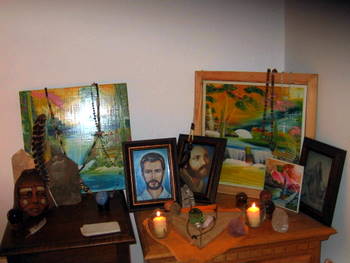
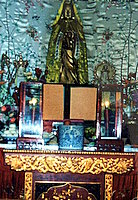 Kuan Yin Altar
Kuan Yin Altar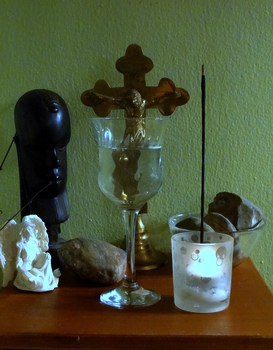
Santeria and Umbanda Altars
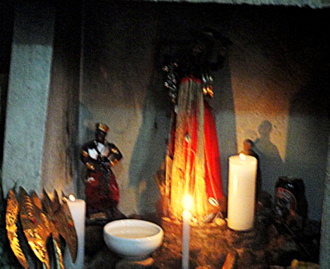 Umbanda Altar
Umbanda AltarIn Santería, an altar is referred to as a boveda. A boveda is typically a small table covered with a white tablecloth. On top of it, there are seven or nine goblets of water, with the largest one placed in the center, dedicated to the individual’s main spirit guide.
In the book "Santería: The Religion" Megene Gonzalez-Wippler explains that practitioners of Santería believe that when a goblet fills with air bubbles, it indicates the presence of spiritual entities, often of a negative nature, nearby. The water thus serves as a form of spiritual cleansing, acting as a subtle 'trap' for impure spirits.
In Jambalaya by Luisah Teish, she gives a guideline for building a small altar. A piece of white cloth, a crystal, chalice filled with water with a tablespoon of anisette, white rum, or white wine (this water is called spirit water), a white candle, four stones, and pictures of ancestors are items needed to create an altar.
In the Umbanda religion, an altar consists of the following essential elements: fire, earth, water, and air. During a recent Umbanda ceremony, the person in charge explained the various items on the temple's altar. There were three candles representing the fire element, each dedicated to specific orishas. I remember one was for Oshun, the Goddess of Rivers and Love. In front of the candles was a glass of water, representing the water element, which is believed to clear and take in all negative energy. A rock was located in front of the glass of water, symbolizing the earth element. Since orishas are earth spirits, having an item representing the earth is considered essential. The air element is self-explanatory.
Note: The air element can be represented by items such as incense, fans, feathers, butterflies, or bells.
Additional items were placed on this specific altar, including a small statue representing the temple's main spirit guide, flowers, and a solid white substance resembling chalk called cascarilla. Cascarilla is made from powdered eggshells. Mediums channeling spirits used cascarilla to inscribe the spirit's name on the ground. In certain spiritual traditions, cascarilla is utilized in spiritual practice -ritual.
Whatever kind of altar you have or are in the process of creating, it is important to remember that LOVE is the main ingredient.
Do burnt offerings (incense) to cleanse and get rid of negative energy.
You decide what is best for you.
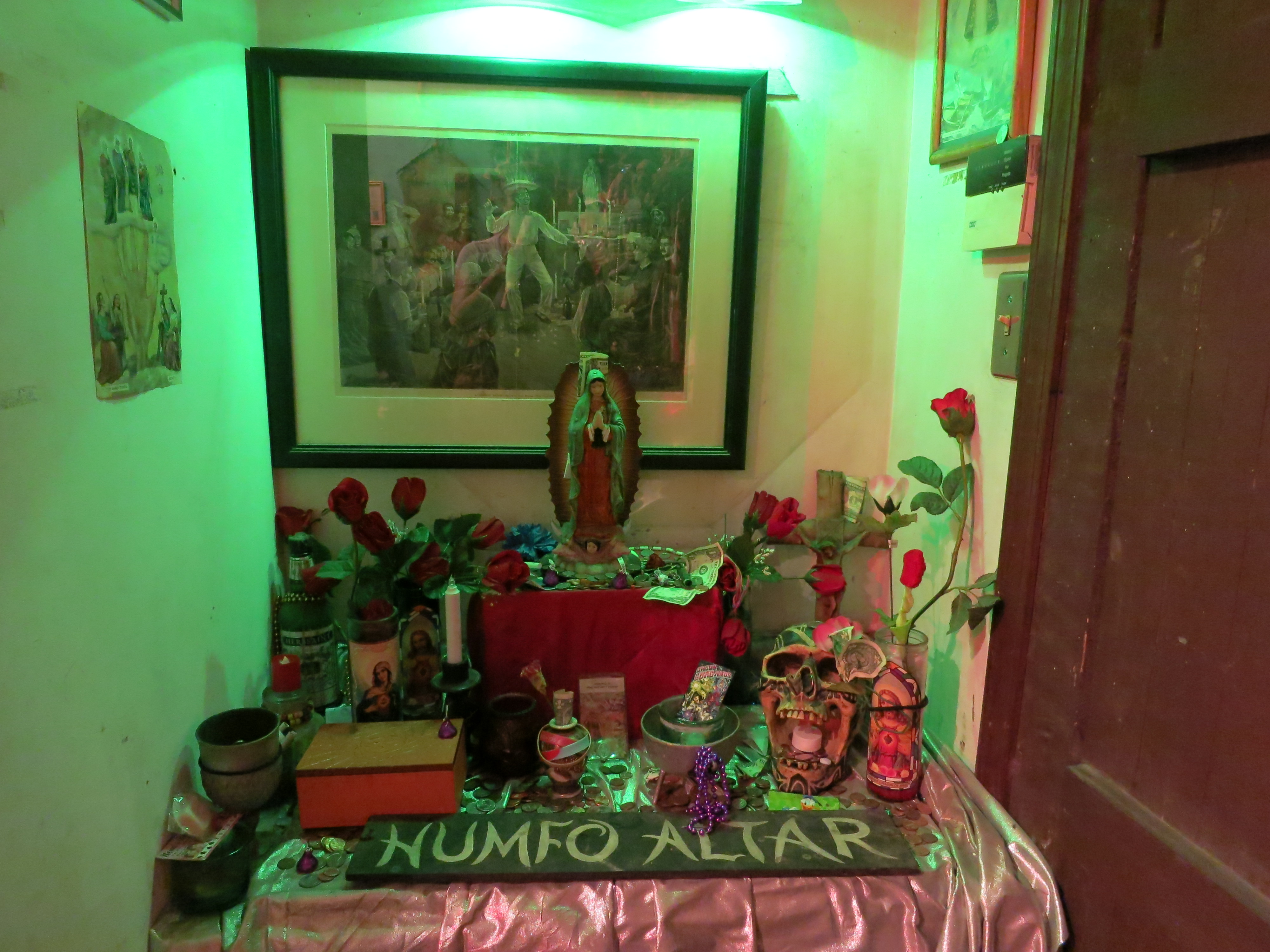 Voodoo Altar
Voodoo AltarSummary
Altars are sacred spaces that act as focal points for spiritual practices, rituals, and connections with the divine. They have evolved from ancient stone structures to elaborate constructions found in temples and churches, reflecting their enduring significance across various cultures and religions. By understanding their historical context, types, and personal uses, we can appreciate the profound role altars play in our spiritual journeys.
Creating and maintaining an altar can enhance your spiritual practice by providing a dedicated space for meditation, prayer, and rituals. The key is to make it a meaningful reflection of your spiritual path.
Embrace the power of your altar to deepen your connection with the divine and enrich your spiritual experience.
Always exercise extreme caution when lighting candles.
Click below and views more than 600 pieces of spiritual artwork

Spiritual Books
If you enjoy the articles on this website, you will also appreciate the short stories in the books below. Click here and continue the journey.



